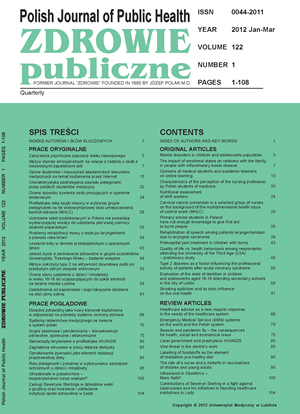Rehabilitation of speech among patients laryngectomized due to laryngeal carcinoma
Keywords:
laryngeal carcinoma, quality of life, rehabilitation of speech, laryngectomyAbstract
Introduction. Laryngeal carcinoma is the most frequent cancer of head and neck. Available literature confirms smoking cigarettes as the most common habit among patients affected with laryngeal and pharyngeal cancer. Despite many symptoms, patients with laryngeal carcinoma rarely refer to hospital and therefore, due to intensive extension of tumor, patients have to be cured with serious surgeries. As a result of larynx removal and loss of phonation organ, patients are unable to communicate verbally. Rehabilitation in case of larynx resection aims to regain speech abilities and bring back patients to the normal social life. Patients also do concern about quality of their life once treatment is accomplished.
Aim. Evaluation of rehabilitation progress among laryngectomized patients treated with various techniques enabling to use speech organ in everyday life.
Material and methods. Studies were conducted among 151 patients with laryngeal carcinoma subjected to larynx removal operation. Patients were hospitalized in the laryngological departments in macro-region of Lublin.
Results. Majority – 88.08% of patients subjected to operation of larynx removal followed phonetic and logopedic rehabilitation. However, only 22% of patients followed instructions given by phoniatrist regarding aspects of speech therapy.
Conclusions. Esophageal speech efficient for basic contact with society was mastered by almost half of patients reaching 57.89 %. Pseudo-whisper was followed by 34.58% of patients, being recognized only by the closest members of society. Writing and gesticulation refers to 7.53% of patients, whereas 11.25% of patients use electrolarynx. Rehabilitation procedures are irregularly followed by patients; patients do not devote enough time for rehabilitation procedures.
References
1. Chęciński P. Rozwój embrionalny i anatomia topograficzna krtani i gardła dolnego. Rak krtani i gardła dolnego. Bielsko Biała: Wyd. Alfamedica Press; 2002. p. 30-49.
2. Zalesska-Kręcińska M, Kręciński T. Zarys otolaryngologii. Wrocław: Akademia Medyczna im. Piastów Śląskich; 2006.
3. Boffetta P, Richiardi L, Berrino F, et al. Occupation and larynx and hypopharynx cancer: an international case-control study in France, Italy, Spain and Switzerland. Cancer Causes Control. 2003;14(3):203-12.
4. Janczewski G. Guzy głowy i szyi. Otolaryngologia u schyłku XX wieku. Gdańsk: Via Medica; 2001. p. 95-7.
5. Leppert W, Majkowicz M, Łuczak J, et al. Ocena jakości życia u chorych z bólem nowotworowym leczonych tramadolem i morfiną. Psychoonkologia. 2002;6(1):1-8.
6. Zatoński W, Zatoński T. Epidemiologia nowotworów złośliwych krtani. W: Rak krtani i gardła dolnego. (ed.) Janczewski G, Osuch- Wójcikiewicz E. Wyd. α-medica Press, Bielsko-Biała 2002, 22-23
7. Wierzbicka M, Szyfter K, Bień S, et al. Zalecenia diagnostyczno-terapeutyczne dla wybranych nowotworów głowy i szyi. Rak gardła. Współ Onkol. 2006;5:202-8.
8. Ackerstaff AH, Hilgers FJM, Aaronson NK, et al. Communication functional disorders and life style changes after total laryngectomy. Clin Otolaryngol. 1994;19:295-300.
9. Sinkiewicz A, Betlejewski S, Betlejewski A, Mackiewicz H. Propozycje standardów postępowania rehabilitacyjnego po laryngektomii całkowitej. Otolaryngol Pol. 2004;58(4):753-6.
10. Fabczak-Kowalczuk AM. Dzienniczek mowy. Białystok: Wyd. Buk; 2005.
11. Krzewicka A, Czernicki J. Rehabilitacja chorych z zaburzeniami głosu i mowy po laryngektomii całkowitej. Przegl Wojsk. 1999;41:499-503.
12. Pruszewicz A, Obrębowski A, Borucińska-Tyczyńska J. Wpływ niektórych czynników socjalnych i psychicznych u laryngektomowanych na rehabilitację zastępczego procesu komunikatywnego. Otolaryng Pol. 1997;31(3):271-6.
13. Wierzbicka M, Wójtowicz JG, Kuśnierkiewicz M, et al. Badanie jakości życia u chorych z nowotworami głowy i szyi w oparciu w oparciu o standaryzowane kwestionariusze EORTC QLQ C-30, EORTC QLQH& N35. In: M. Rogowski (ed) Postępy w otolaryngologii. Mikołajki: Triangulum; 2002. p. 62-71 .


